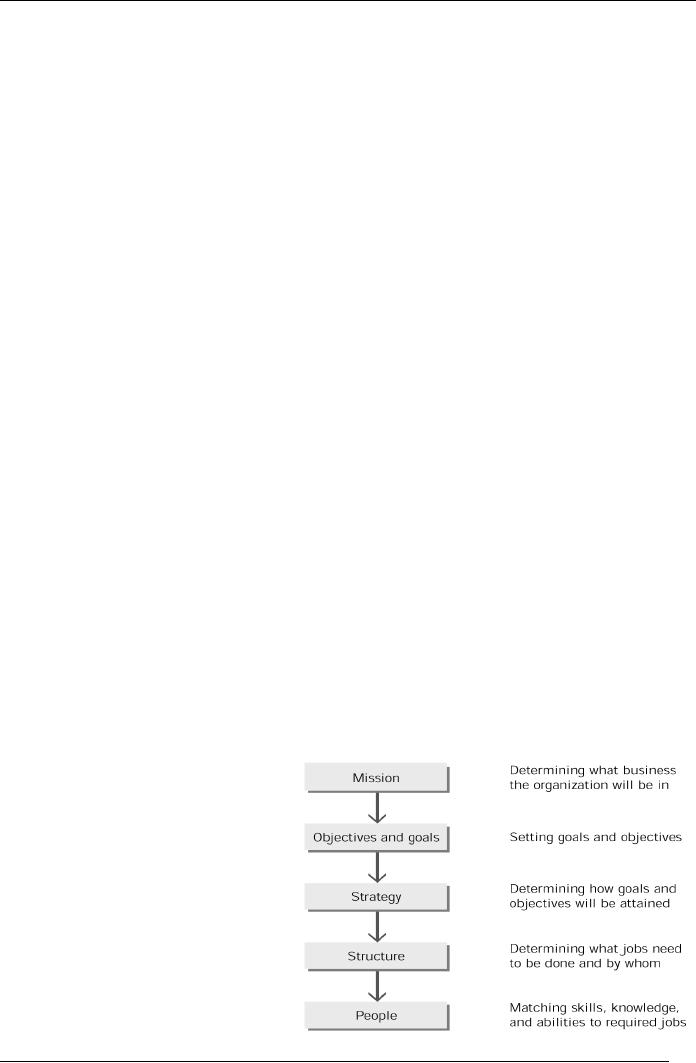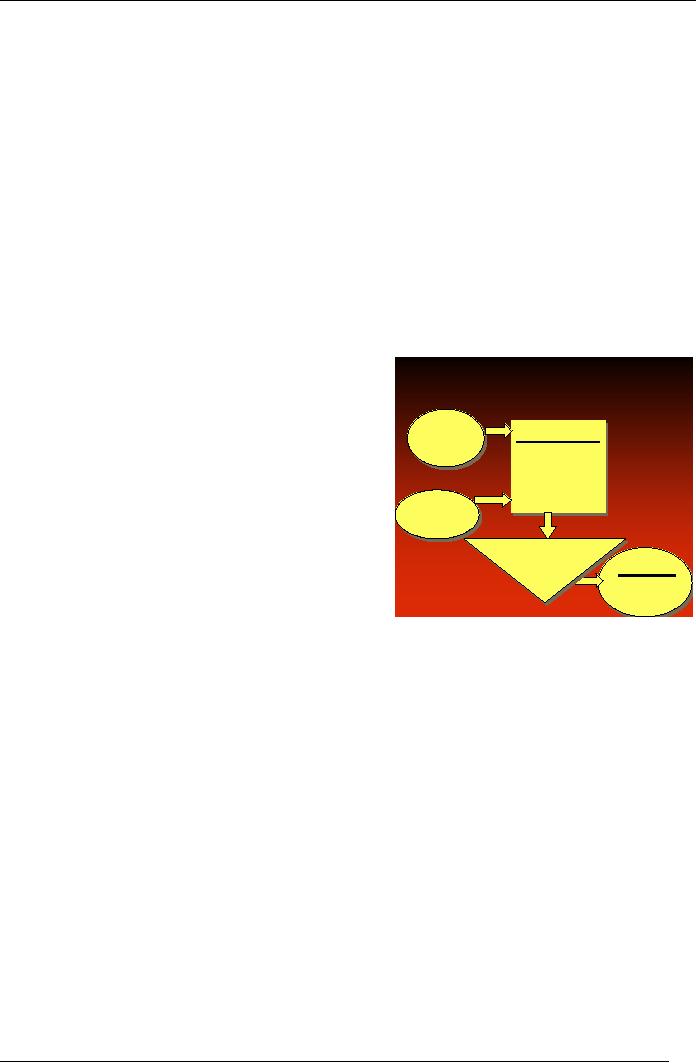 |

Human
Resource Management
(MGT501)
VU
Lesson
45
CONCLUSION
& REVIEW
In
today's lecture, we will be having
overview of the entire course we have
covered in previous modules
and
will
consider the reasons of importance of
HRM.
A.
Human
Resource Management
A
managerial function tries to
match an organization's needs to the
skills and abilities of its
employees.
Attracting
developing, motivating and retaining required talent
and people in organization carries out
this
function.
Workforce of the organization is also being
utilized as a source of competitive
advantage by
acquiring
financial or economic capabilities,
product capabilities, technological or
process capability,
organizational
capability.
B.
Strategies for Gaining Competitive
Advantage
Competitive
advantage refers
to a company's ability to maintain market
share and profitability.
Any
competitive
advantage enjoyed by an organization tends to be
short-lived because other
companies are
likely
to imitate it. This is as true for HR
advantages as for technological and
marketing advantages. For
example,
many high-tech firms have "borrowed"
reward programs for key
scientists and engineers
from
other
successful high-tech firms. The challenge
from an HR perspective is to develop
strategies that offer
the
firm a sustained competitive
advantage. For instance, a
company may develop programs
that maximize
present
employees' potential through carefully
developed career ladders while at the
same time rewarding
them
generously with company
stock with strings attached
(for example, a provision
that they will
forfeit
the
stock if they quit before a certain
date).
a.
Cost
leadership A cost
leadership strategy is a competitive
strategy in which a
company
aims
to become the low-cost leader in the industry by
emphasizing the attainment of
absolute
cost advantages from any
and all sources. Requires a
balance between low
costs
and
acceptable quality.
b.
Differentiation
A
differentiation strategy is a competitive
strategy in which a
company
seeks
to be unique in its industry in a way
that is valued by the customers. HR
strategies
that
fit a differentiation strategy
emphasize innovation, flexibility,
and renewal of the
work
force
by attracting new talent from other
firms, opportunities for mavericks,
and
reinforcement
(rather than discouragement) of creative
flair. The specific HR
strategies
that
are likely to benefit
differentiators include the use of broad
job classes, loose
work
planning,
external recruitment at all levels,
team-based learning, emphasis on what
the
individual
can do (rather than on the job
title held) as a basis for
pay, and reliance on
performance
appraisal as a developmental (rather than a
control) device.
c.
Focus
Strategy: A
focus
strategy
is a competitive
strategy
in which a
company
selects a market
segment
and serves the
customers
in
that
particular
market niche
better
or cheaper than its
competitors.
The focus
strategy
relies
on both a
low-cost
position and
differentiation,
with the
objective
of serving a
narrow
target market
better
than other firms.
The
firm seeks to achieve
197

Human
Resource Management
(MGT501)
VU
differentiation
either from better meeting the needs of
the particular target, or from
lowering
costs in serving this target, or
both. The HR strategies
likely to fit the
focus
strategy
best would be somewhere in the
middle of those described
for low-cost producers
and
differentiators.
C.
The Strategic Management
Process
Strategic
planning is the process of identifying
the business of the firm today and the
business of the firm
for
the future, and then
identifying the course of action it should
pursue. Strategic planning
includes the
first
five strategic management
tasks: evaluating the situation, defining the
business, developing the mission,
translating
the mission into goals, and
then crafting a course of action.
Strategic management includes
the
implementation
phase. The strategic
management process is the continuous
process of identifying
and
pursuing
the organization's mission by aligning internal
capabilities with the external demands of
the
environment.
Step
1: Define the Business and Its
Mission: The
strategic management process
begins with answering
the
question, in what business should we be?
Defining a company's business
involves identifying
several
things:
product scope, vertical integration,
geographic scope, how they
compete. A vision is a
general
statement
of the organizations desired direction
that evokes emotional
feelings in its members. A
mission
statement
outlines the organization's future path
and it communicates its
purpose. Managers base
their
strategic
plans on methodical analyses of their
internal and external
situations.
IV.
Step 2: Translate the mission
into strategic goals: Top
management's vision and
mission are
translated
into operational strategic
goals.
V.
Step 3: Formulate a strategy to
achieve the strategic
goals: A
strategy is a course of action
that
explains
how the organization will move to
achieve its strategic goals
given its internal
strengths
and
weaknesses and its external
opportunities and threats.
Implementation of the strategy
means
translating
the plan strategy into
actions and results, which
requires drawing on the planning,
organizing,
leading, and controlling
functions of management. Top
companies craft strategies
whose
basic principles are easy to
communicate.
VI.
Step 4: Structure: Some
HR strategies fit very well
with highly formalized organizations
that are
divided
into functional areas (for
example, marketing, finance, production,
and so on) and
that
concentrate
decision making at the top. The HR
strategies appropriate for this type of
firm include
a
control emphasis, centralized
pay decisions, explicit job
descriptions, and job-based
pay.
VII.
Step 5: People: People
in organization mean to have workforce in
organization to perform
different
functions. Different set of HR
strategies, include informal hiring
and socializing of
new
employees,
decentralized pay decisions, broad
job classes, and individual-based
pay.
Managers
must be alert to opportunities and
threats that might require
modifying or totally redoing
their
strategies.
Strategic control is the assessing of
progress towards strategic
goals and taking corrective
action
as
needed and keeping the strategy
up-to-date.
D.
Strategic Management
Role:
Strategic
management role is used to
link the firm's HR policies
and practices to the broader,
longer-term
needs of the firm and its
stakeholders. Main responsibilities include
Setting the direction
Crafting
corporate- and business-level plans
developing and implementing functional
plans measuring,
evaluating,
revising and refocusing, the fit
between HR & business
strategy
a.
Enabler and Consultant Role: This
role is used to enabling line
managers to make things
happen
main
responsibilities include, Training, assisting
with problem diagnosis
developing solutions with
managers
being accessible and attuned to employee
needs and concerns
198

Human
Resource Management
(MGT501)
VU
c.
Monitoring
and Maintaining Role: Continuous
monitoring is required to have compliance
with
legal
regulations and effectiveness of HR
activities and this is ensured by the
monitoring role by HR
department.
Main activities performed in this role include
monitoring morale, providing
support
during
change and uncertain
times
d.
Innovator Role: Improving
productivity and quality of
work life it includes:
Adapting to an
environment
of uncertainty, energy conservation, and
international competition, justifying
the
benefits
and costs of programs
Change
and Knowledge Facilitator Role:
This
role is played in order to facilitate
organizational change
and
to maintain the organizational flexibility. It
includes focusing on the future,
guiding the flow of
knowledge,
information and learning throughout the
organization.
E.
High-performance Work System
(HPWS)
A
specific combination of HR practices,
work structures, and
processes that maximizes
employee
knowledge,
skill, commitment, and flexibility is
called high performance work
systems. This system
is
composed
of many interrelated parts that
complement one another to reach the
goals of an organization,
large
or small. This system is based
upon the principles of
Developing
shared
information, knowledge development,
performance
High-Performance
reward
linkage and social equality. High
performance
Work
Systems
work
system can bring
many advantages
to
Liinkages
Lnkages
organization
they mainly include:
SysttemDesiign
Sysem Desgn
tto
o
Employee
Benefits: High
performance
��Worrkfflow
Wok
low
Sttrategy
Srategy
work
systems are beneficent for
employee in
��HRM prractices
HRM
pactices
absence
that they are
provided with
��Supporrt
Suppot
ttechnology
echnology
opportunity
of more involvement
in
Prrnciples
off
Piinciples
o
High
High
organization,
experience
growth
and
Involvementt
Involvemen
satisfaction
specifically through
organizational
The
Implementtaton
The
Implemenatiion
training
and developmental policies and
can
Prrocess
Pocess
OUTCOMES
OUTCOMES
become
more
contributors
towards
��Organzattonall
Organiizaiiona
achievement
of goals and mission of
the
��Employee
Employee
organization.
Organizational
Benefits: Organization
can improve and increase the
productivity; it can
ensure
quality, flexibility in system in
order to have more satisfied
customers.
F.
Selecting HR Strategies to Increase
Firm Performance
No
HR Strategy is "good" or "bad" in
and of itself. The success of HR
strategies depends on the
situation
or
context in which they are
used. In other words, an HR
strategy's effect on firm performance is
always
dependent
on how well it fits with
some of the factors. Fit
refers
to the consistency or
compatibility
between
HR strategies and other
important aspects of the
organization
a.
Fit with Organizational
Strategies
Organizational
strategies may be examined at
two levels: corporate and
business.
Corporate
strategy refers
to the mix of businesses a corporation
decides to hold and the flow
of resources
among
those businesses. This
involves decisions pertaining to
acquisition, divestment, diversification,
and
growth.
At one end of the spectrum is the
evolutionary business strategy; at the
other end is the
steady-
state
strategy. Business
unit strategies refer to
those established by firms or autonomous
units of the
corporation.
Well-known business strategies
were formulated by Porter (overall cost
leadership strategy,
differentiation
business strategy, and focus
strategy) and Miles and
Snow (defender strategy and
prospector
strategy).
b.
Fit
with the
Environment
HR
strategies should help the organization better
exploit environmental opportunities or
cope with the
199

Human
Resource Management
(MGT501)
VU
unique
environmental forces that affect
it. The environment
can be examined on four
dimensions,
including
(1) degree of uncertainty, (2)
volatility, (3) magnitude,
and (4) complexity.
c.
Fit with Organizational
Characteristics
To
be effective, HR strategies must be
tailored to the organization's personality. The
features of an
organization's
personality are its (1)
production process for
converting inputs into output,
(2) market
posture,
(3) overall managerial
philosophy, (4) organizational structure,
and (5) organizational culture.
d.
Fit with Organizational
Capabilities
An
organization's capabilities are its
distinct competencies. HR strategies make
a greater contribution to a
firm's
performance (1) when they
help to exploit the firm's
specific advantages or strengths
while avoiding
its
weaknesses, and (2) when
they assist in better using its
own unique blend of human
resource skills and
assets.
e.
Choosing Consistent and Appropriate HR
Tactics to Implement HR
Strategies
Even
the best-laid strategic HR plans
may fail when specific HR
programs are poorly chosen
or
implemented.
A firm's HR strategies must be
mutually consistent. That
is, HR strategies are more
likely to
be
effective if they reinforce one another rather than
work at cross-purposes.
G.
Expectations for HR
Professionals
Today's
dynamic environment places
some expectations upon the HR
professional to meet the
changing
environment
and contingencies these
expectations are enlisted as
following:
�
Understand
problems assigned
�
Stay
competent and professional through
study and research
�
Maintain
high standards of personal
honesty and integrity
�
Consider
the personal interests, welfare,
and dignity of all employees
affected by recommendations
and
actions
�
Ensure
organizations maintain high regard
for public interest and
personal interests and
dignity of
employees
H.
Current HRM Challenges
a.
Managing
Teams
Team
building--activities aimed at improving
the internal work and relationship
processes of teams--
requires
attention to both task and
interpersonal relationships. In team
building, organizations apply the
principles
of group dynamics to select
complementary members, support
more cohesion, manage stages
of
group
development, and establish constructive
norms that foster high
performance. Membership in teams
is
based
on expertise in areas that
are necessary for task
accomplishment. Trust is the key to
team members'
commitment
to a common goal, mutual accountability,
and collaboration. Trust is
built on six
interdependent
factors: the integrity of the members;
open communication; mutual respect and
support;
fairness
and equity; competence and hard
work; and reward for
cooperation. In addition, clear goals
are a
requirement
for effective teamwork. Members of effective
teams play eight different roles,
all of which are
necessary
for a complete team and
for synergy
b.
Managing
Diversity
A
diverse workforce refers to
two or more groups, each of
whose members are
identifiable and
distinguishable
based on demographic or other
characteristics like gender
age group, education etc.
Several
barriers
in dealing with diversity include stereotyping,
prejudice, ethnocentrism, discrimination,
tokenism,
and
gender-role. Managing diversity means
planning and implementing organizational
systems and practices
to
manage people so that the potential
advantages of diversity are maximized
while its potential
disadvantages
are minimized. Managers are
striving for racial, ethnic,
and sexual workplace balance as
a
matter
of economic self-interest. A study
found that cultural diversity contributes to
improved productivity,
200

Human
Resource Management
(MGT501)
VU
return
on equity, and market
performance.
c.
Managing
Globalization
One
of the most dramatic challenges facing as
they enter the twenty-first century is
how to compete
against
foreign
firms, both domestically and
abroad. Many companies are
already being compelled to think
globally,
something
that doesn't come easily to
firms long accustomed to doing
business in a large and
expanding
domestic
market with minimal foreign
competition.
Weak
response to international competition
may be resulting in upwards layoffs in
every year. Human
resources
can play a critical role in a business's
ability to compete head-to-head
with foreign producers.
The
implications
of a global economy on human resource
management are many. Some
firms try to develop a
global
company identity to smooth over cultural
differences between domestic
employees and those
in
international
operations. Minimizing these
differences increases cooperation and
can have a strong
impact
on
the bottom line. Some firms actively
engage in international alliances
with foreign firms or
acquire
companies
overseas to take advantage of global
markets. Making such
alliances work requires a
highly
trained
and devoted staff. These illustrations
show how firms can use HR
strategies to gain a
worldwide
competitive
advantage.
d.
Managing
Change
Many
organizations face a volatile
environment in which change is
nearly constant. If they are to
survive
and
prosper, they need to adapt to change
quickly and effectively.
Human resources are almost
always at the
heart
of an effective response system. Here
are a few examples of how HR
policies can help or hinder
a
firm
grappling with external change:
I.
Code of Ethics for HR
Professionals:
Ethics
related problems are faced
by the organizations whenever there is a
practice of using
favoritism
rather
than ability or job
performance for managerial
decisions regarding employment,
promotion, pay and
discipline.
These problems can be
reduced and eliminated by maintaining the
highest standards of
professional
and personal conduct,
encouraging employers to make
fair and equitable treatment of
all
employees
a primary concern, maintaining loyalty to
employers and pursue company
objectives in ways
consistent
with the public interest,
upholding all laws and
regulations relating to employer activities,
and
maintaining
the confidentiality of privileged
information. People's expectations
that their employers
will
behave
ethically are increasing, so much
that many firms and
professional organizations have
created codes
of
ethics outlining principles and
standards of personal conduct for
their members. These
negative
perceptions
have worsened over the
years. The widespread
perceptions of unethical behavior may
be
attributed
to the fact that managerial decisions
are rarely clear-cut. Except in a
few blatant cases (such
as
willful
misrepresentation), what is ethical or unethical is
open to debate. Even the most detailed
codes of
ethics
are still general enough to
allow much room for
managerial discretion. In other words,
many specific
decisions
related to the management of human
resources are subject to judgment
calls. Workplace
Flexibility:
collaborative work in a virtual
office
J.
How
Can You Gain Support for
"Best HR Practices?"
Managers
can gain support for
best HR practices by linking the
use of HR practices to the solution of
real
business
problems, and to achieving tangible
business goals. This
achievement of goals requires
selection of
well
defined and specific,
measurable and realistic
goals and communicating the expected
standard of
performance
to workers. Managers should demonstrate
how the benefits outweigh the costs of
using "best
HR
practices." Speak the language of
business people, i.e., money, not
correlation coefficients! Etc.
K.
Future HR Trends:
Workplace
Flexibility: collaborative
work in a virtual office as
well as flexible work hours
is
one
of future HR trends.
201

Human
Resource Management
(MGT501)
VU
Global
Business: borderless
business requires a global workforce to
perform the function at
international
business level.
Work
& Society: working
to live, not living to
work
Workforce
Development: constant
learning in a just-in-time format, learning
organization &
high
skill utilization
Definition
of Jobs: jobs
get bigger & broader
Strategic
Role of HR: becoming
leaders, not just
partners
The
Value of Predicting: having a
vision & a way to achieve
it.
Key
issues of the organization are to achieve
efficiency, effectiveness and
competitiveness and this can
be
done
by using not ignoring the
Knowledge and experience are
available. Because most of the time
Best HR
Practices
are not used because of
Resistance to change, Ignorance on the
part of decision makers
and
Political
considerations. By overcoming these three
factors we can have more
effectively managed
organizations
by using HR practices.
THE
END
202
Table of Contents:
- INTRODUCTION TO HRM:Growing Importance of HRM, Road Map of the Course
- ESSENTIALS OF MANAGEMENT:Concepts and Essential of Management, Manager’s Roles
- ORGANIZATION AND COMPONENTS OF ORGANIZATION:Open versus Closed Systems, The Hawthorne Studies
- PEOPLE AND THEIR BEHAVIOR:Why to work in organizations?, The Goals of Organizational Behavior
- INDIVIDUAL VS. GROUP BEHAVIOR:What Are Roles?, Problem solving Team
- PERSONNEL MANAGEMENT TO HUMAN RESOURCE MANAGEMENT:Records and Administration, Competitive Advantage
- HRM IN A CHANGING ENVIRONMENT:Productivity, New Trends at Work Place
- How organization Cultivate a Diverse Workforce, STEPS TOWARD MANAGEMENT OF DIVERSITY
- FUNCTIONS AND ENVIRONMENT OF HRM:Compensation and Benefits, Safety And Health, Interrelationships of HRM Functions
- LINE AND STAFF ASPECTS OF HRM:Authority, Line versus Staff Authority, Staff Manager
- LEGAL CONTEXT OF HR DECISIONS:Doing the Right Thing, Affirmative Action, Unintended Consequences
- HUMAN RESOURCE PLANNING (HRP):Benefits of HR Planning, Forecasting Human Resource Availability
- STRATEGIC PLANNING AND HRIS:HR’s Strategic Role, Human Resource Information System, Common HRIS Functions
- JOB ANALYSIS:Purposes of the job Analysis, Questions Job Analysis Should Answer
- JOB ANALYSIS:Methods of Collecting Job Analysis Information, Observation, Source of Data
- JOB ANALYSIS (CONTD.):SURPLUS OF EMPLOYEES FORECASTED, Diversity through Recruiting Efforts
- SOURCES OF RECRUITMENT:ALTERNATIVES TO RECRUITMENT, Quantity of the Applicants, Quality of the Applicants
- SELECTION:Initial Screening, Advantages of Successful Screening
- SELECTION TESTS:Characteristics of Properly Designed Selection Tests, Guidelines for Conducting an Interview
- SELECTION PROCESS… CONTD:Background Investigations, Physical Exam, Selecting Managers
- SOCIALIZATION:Compensation and Benefits, Team Membership, Stages in socialization Process, Training and Development Trends
- TRAINING AND DEVELOPMENT:Learning, Phases of Training, Why Transfer of Training Fails
- MAXIMIZING LEARNING:Following up on Training, Repetition, Feedback, Purposes of T & D
- CAREER MANAGEMENT:Individual career planning, Career Planning and Development Methods
- PERFORMANCE:Determinants of Job Performance, Why is performance measured?, Performance Management
- PERFORMANCE APPRAISAL:What to Evaluate, The Appraisal Interview, PROBLEMS IN PERFORMANCE APPRAISAL
- JOB EVALUATION AND PRICING:THE APPRAISAL PERIOD, Ranking method,
- COMPENSATION SYSTEM:Pay, Job Pricing, Compensation: An Overview, Compensation Surveys
- BENEFITS:Total Compensation, Discretionary Benefits (Voluntary), Workplace Flexibility
- ROLE OF MONEY IN PERFORMANCE OF EMPLOYEES:Types of Pay-for-Performance Plans, Empower Employees
- MOTIVATION:The Motivation Process, Motivational Theories, Challenges of motivating employees
- OCCUPATION, HEALTH & SAFETY:Physical Conditions, Accident Investigation, Smoking in The work place
- STRESS MANAGEMENT:Symptoms of Stress, Managing Stress,
- COMMUNICATION IN ORGANIZATION:Burnout, Social Support at Work & Home, Communication in organization, Meetings
- TRADE UNIONS:Collective Bargaining, The HRM Department in a Nonunion Setting, Phases of Labor Relations
- CONFLICT AND NEGOTIATION:Transitions in Conflict Thought, Individual Conflict Management Styles
- POWER AND POLITICS:Sources of Power, Advantages and Disadvantages of PowerPower and Politics in Context
- EMPLOYEE RIGHTS AND DISCIPLINE:Contractual Rights, Management Rights, Disciplining Employees,
- DISCIPLINE (CONT...):Factors to Consider when Disciplining, Disciplinary Guidelines, Employee Separations
- LEADERSHIP:The Leader’s Behavior, Situational Theories of Leadership, Becoming a Leader
- REVISION (LESSON 12-21):Plans, Job Specification, Human resource planning, Selection Process, Corporate Culture
- REVISION (LESSON 22-26):Training, Case Study Method, Training, Performance
- REVISION (LESSON 27-35):Classification Method, Compensation, Empowerment, Mediation
- INTERNATIONAL DIMENSIONS OF HRM:Global Corporation, Type of staff members, Approaches to Global Staffing
- CONCLUSION & REVIEW:Strategies for Gaining Competitive Advantage, High-performance Work System